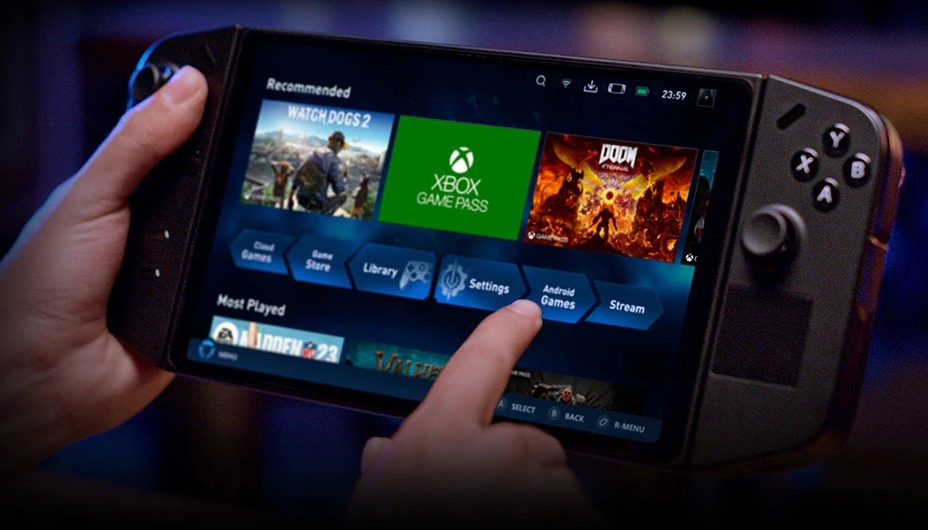
ASUS ROG Ally vs. Lenovo Legion Go vs. Steam Deck OLED: Comparison and Reviews 2025
ASUS ROG Ally Reviews
Equipped with an AMD Ryzen Z1 extreme processor, a smooth 7-inch 1080p 120Hz touchscreen with AMD FreeSync technology, and ROG intelligent cooling, the ROG Ally takes handheld gaming on to a whole different level.You can access any game that runs on Windows across all game platforms, including Steam, GOG, Xbox Game Pass, cloud gaming services, Android apps and more. Play anywhere, anytime, using handheld mode or by connecting the Ally to a TV and linking multiple controllers to play with friends. The Ally even transforms into a gaming PC by connecting to ROG XG mobile eGPU and dock - supporting mouse, keyboard, monitor, and more of your favorite peripherals.

Pros & Cons
| Pros | Cons |
|
|
Lenovo Legion Go Reviews
The Lenovo Legion Go is the latest gaming handheld looking to topple the mighty Steam Deck. With its large 8.8-inch 144Hz display, powerful AMD Ryzen 1 Extreme processor and detachable controllers, this Windows 11-powered portable gaming system has a lot going for it.
Packing a 2,560 x 1,600 8.8-inch OLED display, the Legion Go has one of the largest, if not the largest screens on any gaming handheld today. But it’s not just big, because with a 144Hz refresh rate, it’s rather speedy and thanks to a peak brightness of around 500 nits, it’s pretty vibrant too. This makes the panel a great centerpiece for Lenovo’s handheld. The only thing it’s missing is full variable refresh rate support (VRR).

Pros & Cons
| Pros | Cons |
|
|
Steam Deck OLED Reviews
At first glance, the Steam Deck OLED looks much like its predecessor; almost exactly the same, in most regards. Both the Steam Deck and Steam Deck OLED measure 4.6 by 11.7 by 1.9 inches (HWD), with the OLED just slightly lighter at 1.41 lbs, compared to the original Steam Deck’s 1.48 lbs. Two analog sticks flank the screen's left and right corners, while the square trackpads sit south of them. On the top, you’ll find a USB-C port and headphone jack. On the bottom, a microSD card slot—just like the original model.
The screen is the star of the show, and it’s one of the system's major upgrades. Slightly bigger at 7.4 inches measured diagonally (compared to the 7-inch Steam Deck display) the new system swaps the IPS display for an OLED. OLED panels blow IPS and VA displays out of the water when it comes to color gamut, viewing angles, and power efficiency. Deeper blacks and more vibrant colors help the visuals pop on the smaller screen, especially considering that the resolution remains at 1200 by 800 pixels. The screen features no VRR support, but a recent update made it possible if connected to an external display via Steam Deck Dock.

Pros & Cons
| Pros | Cons |
|
|
Where to Buy Handheld Gaming Consoles?
You can buy handheld gaming consoles at brands' official website (like ASUS 1% Super Cash Back, Lenovo 3% Super Cash Back). You can also go Best Buy, GameStop, Walmart.com, or Amazon.com to purchase handheld gaming consoles.
Saving Tip: If you like online shopping, don't forget to sign up at Extrabux!(What is Extrabux) , then you can enjoy up to 30+% cashback on your purchase from Extrabux! Sign-Up Bonus: Free to join it & get $20 welcome bonus! Student Benefits:As long as you are a student at school, you can get a free whole year long VIP Card worth $199.
Extrabux.com cooperates with many merchants, such as: Best Buy (0.5% cashback), GameStop (Up to 7% cashback), Walmart (Up to 4% cashback), Sephora(4% -5% cash back), Moosejaw (5% -6% cash back), LOOKFANTASTIC (Up to 10% cash back), Giorgio Armani Beauty(10-12% cashback) )Sam's Club (Up to 15% cashback), Norton(Up to 20% cashback), Microsoft (Up to 7% cash back) and so on. You can save on buying daily necessities, fashion, beauty, electronic products, broadband installation, mobile communication, air tickets, hotels and other aspects of life!
ASUS ROG Ally vs. Lenovo Legion Go vs. Steam Deck OLED
Below we will look at these three handheld gaming consoles from top to bottom. This includes their specs, price & avaliablity, designs, pros & cons, dispaly, software, controls, features, battery life, and more!
1. By the Specs
| ASUS ROG Ally | Lenovo Legion Go | Steam Deck OLED | |
| Price | Starting at $599.99 | Starting at $699.99 | Starting at $549 |
| Release Date | June 13, 2023 | November 1, 2023 | November 16, 2023 |
| Display | 7″ 1920×1080 (16:9), 120 Hz, 500 nits | 8.8” 2560x1600 (16:10), 144Hz, 500 nits | 7.4" 1280 x 800 x RGB, 1,000 nits peak brightness (HDR) 600 nits (SDR) |
| Processor | AMD Ryzen Z1 & Z1 Extreme (Zen 4) | AMD Ryzen Z1 & Z1 Extreme (Zen 4) | AMD Zen 2 CPU |
| Graphical Architecture | RDNA 3 | RDNA 3 | 8 RDNA 2 CUs, 1.6GHz (1.6 TFlops FP32) |
| RAM | 16GB LPDDR5 @ 6400MT/s | 16GB LPDDR5X @ 7500Mhz | 16 GB LPDDR5 on-board RAM (6400 MT/s quad 32-bit channels) |
| Storage | 256GB / 512GB NVMe M.2 SSD | 256GB / 512GB / 1TB NVMe M.2 SSD | 512GB / 1TB NVMe SSD |
| Battery Capacity | 40Wh, 65W USB Type-C Charger | 49.2Wh, 65W USB Type-C Charger | 50Whr battery. 3-12 hours of gameplay |
| Operating system | Windows 11 Home | Windows 11 Home | SteamOS 3 (Arch-based) |
| Ports | 1x USB-C, 1xCustom Asus PCIe port, 3.5mm headphone jack, Wi-Fi 6E, Bluetooth 5.2 | 2xUSB Type-C, 1xmicroSD slot, 3.5mm headphone jack, Wi-Fi 6E, Bluetooth 5.2 | PD3.0 Type C power supply, 3.5mm stereo headphone / headset jack, Bluetooth 5.3 |
| Size | 280mm × 111mm × 212mm (11.0in × 4.4in × 8.3in) | 299mm x 131mm x 41mm (11.8in x 5.15in x 1.61in) | 298mm x 117mm x 49mm |
| Weight | 608g | 854g | Approx. 640 grams |
2. Price: Steam Deck OLED is the Winner
In terms of price, the Steam Deck OLED is the cheapest of the three portable gaming consoles. The 512GB version is $549, while the 1TB version is $649 -- which is pretty fantastic, since these were basically the prices of the Steam Deck higher-config models previously. $649 now nets you twice the storage, an OLED display, a better battery and a lot of other improvements.
However, the Asus ROG Ally and Lenovo Legion Go are priced at $699 with both models feature the AMD Ryzen Z1 Extreme chip. The Ally does have a cheaper $599 variant that comes equipped with an AMD Ryzen Z1 chip. However, Lenovo has also confirmed that another, cheaper AMD Ryzen Z1 model for the Legion Go will eventually come to market.
If you want the best bang for your buck, Valve's Steam Deck OLED is the way to go. However, if you want the best gaming experience with high fidelity graphics and better performance you might want to check out the Lenovo Legion Go.
3. Display: Lenovo Legion Go is the Winner
The display is one of the most important specs in a handheld gaming console. The Lenovo Legion Go is a clear winner in this case as it uses a huge 8.8-inch QHD+ screen with a 2560x1600p resolution and a 144Hz refresh rate. However, the ROG Ally features a 7-inch FHD+ screen with a 1920×1080p resolution and a 120Hz refresh rate. And the Steam Deck OLED comes with a 7.4” HDR OLED screen with 1280 x 800p resolution and a up to 90Hz refresh rate.
The display of ROG Ally and Steam Deck OLED is not so good when compared with Lenovo Legion Go.
4. Battery: Steam Deck OLED Strikes Again
The Steam Deck OLED with a 50Whr battery. On the other hand, The ROG Ally with a 40Wh battery and the Lenovo Legion Go with a 49.2Wh battery. Obviously, the Steam Deck OLED offers the largest battery capacity.
But it should be noted that The Steam Deck has a longer battery life, but that is only due to the low power consumption from the CPU and its limited resolution. In terms of charging speed, both Legion Go and ROG Ally come with a 65W USB-C charger that can potentially charge them from zero to 100% in half the time it takes for the Steam Deck.
5. Portability: ASUS ROG Ally is the Winner
In terms of ergonomics, all three devices have their fair share of advantages, but we find the ROG Ally to be the most handheld-friendly and convenient to carry while traveling. It is, in fact, the lightest of the three. You'll immediately feel the difference just by lifting up the three devices one after the other. Meanwhile, the ROG Ally also has the best grip, especially when played against a surface and held at an angle facing towards your face.
Playing with the ROG Ally while walking or while carrying it around isn't as ideal as the Lenovo Legion Go Legion Go, so it loses out a bit in the battle where the two devices are being played on the go, like while commuting or while walking home. However, we still think that portability is king here, especially since you don't really get to enjoy playing until you're comfortably sat down on a table or in bed. With that said ROG Ally takes the win here.
6. Operating System: The Steam Deck OLED Still Has the Advantage of Software
Having a reliable operating system makes for a good user experience. Arguably the best-selling point of the Steam Deck is its software, and that remains unchanged with the arrival of the OLED version. Of course, there are caveats here wherein the Legion Go and the ROG Ally offer a closer experience to an actual desktop thanks to their Windows OS, but the Steam Deck's SteamOS and custom Linux desktop OS have an edge in terms of flexibility. The Steam Deck also allows you seamless access to your Steam library.
One underappreciated but still important aspect of this is the Steam Deck's compatibility grading system, as developers strive to meet the Verified mark for the Steam Deck. Unbeknownst to many, Verified games actually automatically configure themselves to the Steam Deck control layout. For those that don't have the same mark, community loadouts also exist that allow players to configure their own controls for non-verified games. It's been rare, but there have been instances where players still had to map their game controls to their Legion Go or ROG Ally just because the games don't automatically configure themselves.
Finally, it's also underappreciated how the Steam Deck OS smoothly integrates your Steam library into your gaming system. It's very convenient how you can just pick up your Steam Deck and open your library seamlessly, choosing a game and heading straight into play. The other two don't have the same convenience here, so we're giving this entire section to the Steam Deck.
But it should be noted that both ROG Ally and Legion Go can run Windows 11 natively. Due to this, they have access to almost all PC game libraries including Steam, Epic Games, Xbox Game Pass, and more.
7. Performance: The Legion Go Has the Best Performance
The Steam Deck OLED also received performance upgrades on top of its display improvements, carrying with it a more efficient AMD APU, but the upgrade comes as an efficiency improvement more than anything. With the better battery capacity and the more efficient processor, the Steam Deck OLED added a lot of beef to its battery life. However, in terms of raw processing power, the Legion Go's AMD Ryzen Z1 (which is also the same processor used by the ROG Ally) still is the better processing chip versus the bespoke Steam Deck's Zen 2.
In terms of performance, the only difference between ROG Ally and Legion Go is that the latter has faster RAM. The Lenovo Legion Go comes with 16GB LPDDR5X RAM clocked at a speed of 7500Mhz. Compared to that, the Ally features a 16GB LPDDR5 RAM with a speed of 6400Mhz. Since both handheld consoles run the same OS, Lenovo's Legion Go can be slightly faster than Asus ROG Ally, thanks to faster RAM.
Other than that, the Ally also has a custom Asus PCIe port that can be used to connect external GPUs. However, this feature is only practical when playing on a bigger screen and not in handheld mode.
8. Design: A Three-Way Draw
If the answer is an unassuming slab that has been sculpted for optimal gameplay over a long period, then the Steam Deck is a good way to go. The ergonomics make it a console that just slips into your hand’s natural grip with ease. Nothing is too far out of reach for your fingers and thumbs, vents and fans are strategically placed to avoid heating up your hands too much, and the weight is evenly distributed, so as to not feel imbalanced. Plus, the right to repair goodness here means it's super easy to open and fix/replace any broken parts — something that is a struggle elsewhere.
The Asus ROG Ally doesn’t quite have the same sculpted edges of the Steam Deck, but more importantly to those who want better portability, it is smaller and lighter. I also greatly prefer the in your face futurism aesthetic of the Ally over the more muted presence of Valve’s machine. However, the Lenovo Legion Go is rather chunky, and that size is definitely going to be polarizing. The ergonomics are equally as sound as the Steam Deck, while also offering the option to completely detach the controllers for easy multiplayer a la Nintendo Switch.
9. Features: The Legion Go Has the Most Features
Lenovo designed the Legion Go and stuffed as many features as they could into it, making it the most unique of the three devices. First off, the Legion Go's detachable controllers ala Nintendo Switch are a great improvement from the original Steam Deck design. It's an elegant improvement that completely adds a lot of value to the Legion Go, making it more couch co-op multiplayer-friendly, and more versatile. Its right controller can also morph into a vertical controller and serve as a makeshift mouse or even as an FPS controller. These features make the Legion Go a lot of unique selling propositions.
Meanwhile, the Legion Go also has a sturdy kick-stand that lets you prop the device on a flat surface – something that neither the ROG Ally nor the Steam Deck OLED can do. The most obvious use for this is when you detach the controllers and play with your hands off the device – but this is also a great way to turn your Legion Go into a small theater where you can watch your favorite shows on the go. It even goes well with its larger and higher resolution display.
Verdict: Which One Is Best For You?
The Legion Go has a bigger and better display, more impressive internal specs, detachable controllers, and requires much less effort to play games from a variety of online storefronts. The Lenovo Legion Go differs from other Windows 11-based handhelds thanks to a larger display and detachable controllers. And at $699 to start, it’s a direct competitor to the Asus ROG Ally, which lacks the former’s distinctive features.
Though I appreciate Lenovo’s efforts with the Legion Go, it doesn’t deliver the seamless experience I look for in a handheld. Doing anything outside of the Legion Space launcher is clumsy since most Windows programs don’t recognize button inputs.
While the Legion Go’s performance is comparable to the ROG Ally, neither provides a massive leap over Steam Deck unless you lower the resolution to 720p — which makes games look atrocious on the 8.8-inch display. And while (trying) to use the right controller as a pseudo mouse is interesting, it doesn’t function all that well.
For most people, the Steam Deck OLED is the better option over the Lenovo Legion Go. Valve’s device offers a richer display, better game optimization and an intuitive interface designed for the hardware. On top of that, even the high-end $649 Steam Deck OLED is more affordable than the Lenovo Legion Go.
Overall, quibbles aside, if you’re a PC gamer desiring a unique handheld that offers the versatility of Windows 11, the Lenovo Legion Go is a safe bet. It’s arguably the best Windows 11 handheld out now. However, the Steam Deck OLED still is a solid choice in terms of reliability, compatibility, and comfort in its Steam library integration. Of the three devices, it feels like it's the ROG Ally that quickly aged and is now left behind in the competition, with Valve's timely introduction of a new Steam Deck variant giving it a leg up in the race.

Extrabux is an international cashback shopping site, offering up to 30% cashback from 10,000+ Stores!
Microsoft, Dell, HP, Lenovo, Alienware, Acer, Asus, Samsung, BestBuy, Walmart, Staples, Overstock, QVC, New Egg, Office Depot, eBay, etc.
Join to get $20 welcome bonus now! (How does Welcome Bonus work?)
Recommendation
-

Is Turkish Airlines Good for International Flights?
-

10 Best & Stylish Winter Coats for Women on NET-A-PORTER in 2025
-

Top & Best 12 Sneaker Apps/Websites for Raffles, Releases & Restocks in 2025
-

7 Best Gift Card Exchange Sites - Buy, Sell and Trade Discount Gift Card Safely and Instanly!
-

Top 9 Professional Skincare Brands for Licensed Estheticians 2025











